Optimal Demand Response Using Battery Storage Systems and Electric Vehicles in Community Home Energy Management System-Based Microgrids
Abstract
1. Introduction
- The model was tested on a residential community consisting of 40 houses and contained a range of CAs. The study employs community consideration with various classes of consumers. Ten percent of the higher-class community is assumed to consider electric vehicles rated as 70 kWh battery rating Chevy Volt with a charging station of 10 kW power limit. A BES of 132 kWh is also considered.
- A load scheduling and optimal rule-based peak shaving algorithm is proposed that incorporates BES, PV systems, and EV. The peak shaving algorithm takes into account both the dynamic demand and everyday feed-in limits.
- A rule-based control algorithm considering flexible daily management is proposed that provides schedules for charging and discharging EV and battery for peak shaving of the utility grid power. The algorithm also takes into account the day’s feed-in limits and demand, which correspond to limited feed-in powers and utility grid demand.
- The PSO algorithm is employed to obtain the optimal inputs for the suggested rule-based peak shaving management, which is aimed at reducing energy consumption from the utility grid.
2. System Description
3. Optimal Load Scheduling (OLS)
3.1. Usage Patterns of Controllable Appliances in Residential Settings
3.2. Final Objective of Load Scheduling
3.3. Formulation of DHEMS
4. Optimal Peak Shaving (OPS)
4.1. Distributed Energy Resources
4.2. Operating Modes of BES
- (1)
- Discharging Mode: [DCM] When the load demand exceeds the demand limit, and the PV source and EV are unable to provide the required power, the discharge time occurs, i.e., . The EVs are also not available to support the grid due to the nearly expected departure or departed already. The symbol “&&” represents the logical AND operator.
- (2)
- Charging Mode-I: [CM1] The time period corresponds to the situation where the load demand is within the demand limit range, i.e., . The EV, if connected, can absorb/supply the power as per the requirement.
- (3)
- Charging Mode-II: [CM2] This occurs at time when the load demand exceeds the demand limit range, and the PV source is available to provide the required power, i.e., . EVs can absorb power for charging themselves.
- (4)
- Charging Mode-III: [CM3] This occurs at time when the load demand is within the demand limit range and the PV source is unavailable, i.e., . EVs can absorb power if required for day to day management.
4.3. Proposed Technique to Determine Inputs
4.3.1. Demand Limit
4.3.2. Daily Energy Demand for Charging BES
4.3.3. Daily PV Energy Availability for Charging BES
4.3.4. Daily Utility Grid Energy Availability for Charging BES
4.3.5. Utility Grid Energy Coefficient for Charging the BES
4.3.6. Modified Demand Limit
4.3.7. Feed-In Limit
4.4. The Rules Proposed for Peak Shaving Strategy
4.5. Optimal Inputs Estimation
5. Simulation Results
5.1. Case 1: Summer Load Profile with High PV Energy Availability
5.2. Case 2: Winter Load Profile with Low PV Energy Availability
5.3. Case 3: Summer Load Profile with a Cloud Gust
6. Conclusions
- The concept of an optimal demand response is proposed within the context of a community home energy management system based on microgrids. The focus is on incorporating battery storage systems and electric vehicles to enhance the effectiveness of the demand response strategy.
- A novel approach is presented, introducing a dynamic clustered load scheduling strategy tailored for grid-connected photovoltaic (PV) systems, incorporating battery energy storage systems and electric vehicles to effectively manage peak shaving. Furthermore, a rule-based method is employed to optimize the management process.
- By integrating dynamic demand response and optimal peak shaving strategies, the system addresses reduces peak utilization grid power (PUGP) that increases grid stability by reducing reliance on the public grid.
- The experimental results showcase constrained utility grid demand and feed-in powers across various load demand scenarios and PV power profiles.
- The application of particle swarm optimization (PSO) improves the percentage of peak removal by an average of 7%, indicating the effectiveness of the proposed management strategy.
- Future research can focus on enhancing the shared apartment architecture by conducting precise and accurate calculations of electric vehicle (EV), battery energy storage (BES), and photovoltaic (PV) ratings.
- Further investigations can explore the implementation of metaheuristic optimization techniques, such as crow search (CSA) and hybrid grey wolf algorithm (HGWO), considering different types and scenarios of EVs, including vehicle-to-grid (V2G), grid to vehicle (G2V), vehicle-to-everything (V2X) and vehicle-to-vehicle (V2V) operations.
- Exploring these areas in future research will present promising opportunities to improve the overall performance of HEMS and drive advancements in the field of energy management systems within community microgrids.
Author Contributions
Funding
Conflicts of Interest
Nomenclature
| DHEMS | Dynamic clustered home energy management system. |
| MG | Microgrid. |
| PAR | Peak-to-average ratio. |
| HEMS | Home energy management system. |
| PUP | Power usage pattern. |
| IBR | Inclined block rate. |
| PV | Photovoltaic. |
| PSO | Particle swarm optimization. |
| AMI | Advanced metering infrastructure. |
| RTP | Real time electricity pricing. |
| CA | Controllable appliance. |
| ATS | Activation time slot. |
| AST | Starting time for operation of appliance |
| ATL | Time length of appliance operation. |
| AET | Ending time for operation of appliance. |
| LCS | Lower class. |
| MCS | Middle class. |
| BES | Battery Energy Storage. |
| SoC | State of charge. |
| PUGP | Peak utility grid power. |
| PPS | Percentage peak shaving. |
| UMCS | Upper middle class. |
| HCS | Higher class. |
| EC | Electricity cost. |
| ATS for appliance of house . | |
| AET for appliance of house . | |
| ATS for ath appliance of kth house | |
| ATL for appliance of house . | |
| Device rating for ath appliance of kth house | |
| Set of CAs of kth house. | |
| Power consumption profile for appliance of house . | |
| Power consumption value for ath device of kth house, during th time slot. | |
| Time slot. | |
| Power consumption scheduling matrix of size 80 × 144. | |
| Power consumption scheduling vector. | |
| PUP for cluster of community. | |
| Penalty factor. | |
| A threshold based on count of houses under current community. | |
| Power consumption of community being optimized. | |
| Real time electricity price of . | |
| PUP set threshold at 2 kWh. | |
| Current community houses set. | |
| CAs current cluster. | |
| Mean PUP. | |
| , | Utility grid power (kW) and energy (kWh). |
| , , , | EV, battery, PV and load demand powers (kW). |
| , | Feed-in and demand limits of the day (kW). |
| Energy required for charging battery (kWh). | |
| Battery maximum charging power (kW). | |
| , | Available utility grid and PV energy for battery charging (kWh). |
| Dischargeable energy of the battery (kWh). | |
| Maximum battery discharge power (kW). | |
| Rated energy capacity of battery (kWh). | |
| Coefficient of utility grid energy to charge the battery. | |
| , | Discharging and charging power of battery (kW). |
| , | Starting and ending SoC of the day. |
| , | Upper and lower limits of SoC. |
References
- Chen, B.; Wang, J.; Lu, X.; Chen, C.; Zhao, S. Networked Microgrids for Grid Resilience, Robustness, and Efficiency: A Review. IEEE Trans. Smart Grid 2021, 12, 18–32. [Google Scholar] [CrossRef]
- Ahmed, M.; Meegahapola, L.; Vahidnia, A.; Datta, M. Stability and Control Aspects of Microgrid Architectures—A Comprehensive Review. IEEE Access 2020, 8, 144730–144766. [Google Scholar] [CrossRef]
- Moazeni, F.; Khazaei, J.; Asrari, A. Step Towards Energy-Water Smart Microgrids; Buildings Thermal Energy and Water Demand Management Embedded in Economic Dispatch. IEEE Trans. Smart Grid 2021, 12, 3680–3691. [Google Scholar] [CrossRef]
- Leitão, J.; Gil, P.; Ribeiro, B.; Cardoso, A. A Survey on Home Energy Management. IEEE Access 2020, 8, 5699–5722. [Google Scholar] [CrossRef]
- Espina, E.; Llanos, J.; Burgos-Mellado, C.; Cárdenas-Dobson, R.; Martínez-Gómez, M.; Sáez, D. Distributed Control Strategies for Microgrids: An Overview. IEEE Access 2020, 8, 193412–193448. [Google Scholar] [CrossRef]
- Ali, S.; Rehman, A.U.; Wadud, Z.; Khan, I.; Murawwat, S.; Hafeez, G.; Albogamy, F.R.; khan, S.; Samuel, O. Demand Response Program for Efficient Demand-Side Management in Smart Grid Considering Renewable Energy Sources. IEEE Access 2022, 10, 53832–53853. [Google Scholar] [CrossRef]
- Abbasi, A.; Sultan, K.; Aziz, M.A.; Khan, A.U.; Khalid, H.A.; Guerrero, J.M.; Zafar, B.A. A Novel Dynamic Appliance Clustering Scheme in a Community Home Energy Management System for Improved Stability and Resiliency of Microgrids. IEEE Access 2021, 9, 142276–142288. [Google Scholar] [CrossRef]
- Zhang, Z.; Wang, Z.; Wang, H.; Zhang, H.; Yang, W.; Cao, R. Research on Bi-Level Optimized Operation Strategy of Microgrid Cluster Based on IABC Algorithm. IEEE Access 2021, 9, 15520–15529. [Google Scholar] [CrossRef]
- Dong, X.; Li, X.; Cheng, S. Energy Management Optimization of Microgrid Cluster Based on Multi-Agent-System and Hierarchical Stackelberg Game Theory. IEEE Access 2020, 8, 206183–206197. [Google Scholar] [CrossRef]
- Waseem, M.; Lin, Z.; Liu, S.; Sajjad, I.A.; Aziz, T. Optimal GWCSO-based home appliances scheduling for demand response considering end-users comfort. Electr. Power Syst. Res. 2020, 187, 106477. [Google Scholar] [CrossRef]
- Aziz, M.A.; Qureshi, I.M.; Cheema, T.A.; Rashid, E.A. Community based home energy management system. IIUM Eng. J. 2017, 18, 43–55. [Google Scholar] [CrossRef]
- Aziz, M.A.; Qureshi, I.M.; Cheema, T.A.; Malik, A.N. Time based device clustering for domestic power scheduling. Int. J. Adv. Appl. Sci. 2016, 1, 1–9. [Google Scholar] [CrossRef]
- Leadbetter, J.; Swan, L. Battery storage system for residential electricity peak demand shaving. Energy Build. 2012, 55, 685–692. [Google Scholar] [CrossRef]
- Abbasi, A.; Khalid, H.A.; Habib, R.; Khan Adnan, U. A Novel Dynamic Load Scheduling and Peak Shaving Control Scheme in Community Home Energy Management System Based Microgrids. IEEE Access 2023, 11, 32508–32522. [Google Scholar] [CrossRef]
- Lei, T.; Min, Z.; Gao, Q.; Song, L.; Zhang, X.; Zhang, X. The Architecture Optimization and Energy Management Technology of Aircraft Power Systems: A Review and Future Trends. Energies 2022, 15, 4109. [Google Scholar] [CrossRef]
- Reddy, K.R.; Meikandasivam, S. Load Flattening and Voltage Regulation Using Plug-In Electric Vehicle’s Storage Capacity with Vehicle Prioritization Using ANFIS. IEEE Trans. Sustain. Energy 2020, 11, 260–270. [Google Scholar] [CrossRef]
- Hafiz, F.; Awal, M.A.; Queiroz, A.R.d.; Husain, I. Real-Time Stochastic Optimization of Energy Storage Management Using Deep Learning-Based Forecasts for Residential PV Applications. IEEE Trans. Ind. Appl. 2020, 56, 2216–2226. [Google Scholar] [CrossRef]
- Lengyel, L. Validating rule-based algorithms. J. Appl. Sci. 2015, 12, 59–75. [Google Scholar]
- Kumar Jha, U.; Soren, N.; Sharma, A. An Efficient HEMS for Demand Response Considering TOU Pricing Scheme and Incentives. In Proceedings of the 2018 2nd International Conference on Power, Energy and Environment: Towards Smart Technology (ICEPE), Shillong, India, 1–2 June 2018; pp. 1–6. [Google Scholar] [CrossRef]
- Bruno, S.; Giannoccaro, G.; La Scala, M. A Demand Response Implementation in Tertiary Buildings Through Model Predictive Control. IEEE Trans. Ind. Appl. 2019, 55, 7052–7061. [Google Scholar] [CrossRef]
- Celik, B.; Roche, R.; Suryanarayanan, S.; Bouquain, D.; Miraoui, A. Electric energy management in residential areas through coordination of multiple smart homes. Renew. Sustain. Energy Rev. 2017, 80, 260–275. [Google Scholar] [CrossRef]
- Mahmud, K.; Hossain, M.J.; Town, G.E. Peak-Load Reduction by Coordinated Response of Photovoltaics, Battery Storage, and Electric Vehicles. IEEE Access 2018, 6, 29353–29365. [Google Scholar] [CrossRef]
- Greenwood, D.M.; Wade, N.S.; Taylor, P.C.; Papadopoulos, P.; Heyward, N. A Probabilistic Method Combining Electrical Energy Storage and Real-Time Thermal Ratings to Defer Network Reinforcement. IEEE Trans. Sustain. Energy 2017, 8, 374–384. [Google Scholar] [CrossRef]
- Riffonneau, Y.; Bacha, S.; Barruel, F.; Ploix, S. Optimal Power Flow Management for Grid Connected PV Systems with Batteries. IEEE Trans. Sustain. Energy 2011, 2, 309–320. [Google Scholar] [CrossRef]
- Angenendt, G.; Zurmühlen, S.; Mir-Montazeri, R.; Magnor, D.; Sauer, D.U. Enhancing battery lifetime in PV battery home storage system using forecast based operating strategies. Energy Procedia 2016, 99, 80–88. [Google Scholar] [CrossRef]
- Vedullapalli, D.T.; Hadidi, R.; Schroeder, B. Combined HVAC and Battery Scheduling for Demand Response in a Building. IEEE Trans. Ind. Appl. 2019, 55, 7008–7014. [Google Scholar] [CrossRef]
- Manojkumar, R.; Kumar, C.; Ganguly, S.; Catalão, J.P.S. Optimal Peak Shaving Control Using Dynamic Demand and Feed-In Limits for Grid-Connected PV Sources With Batteries. IEEE Syst. J. 2021, 15, 5560–5570. [Google Scholar] [CrossRef]
- Erdinc, O.; Paterakis, N.G.; Mendes, T.D.P.; Bakirtzis, A.G.; Catalão, J.P.S. Smart Household Operation Considering Bi-Directional EV and ESS Utilization by Real-Time Pricing-Based DR. IEEE Trans. Smart Grid 2015, 6, 1281–1291. [Google Scholar] [CrossRef]
- Sadeghian, O.; Oshnoei, A.; Mohammadi-ivatloo, B.; Vahidinasab, V.; Anvari-Moghaddam, A. A comprehensive review on electric vehicles smart charging: Solutions, strategies, technologies, and challenges. J. Energy Storage 2022, 54, 105241. [Google Scholar] [CrossRef]
- Dik, A.; Kutlu, C.; Omer, S.; Boukhanouf, R.; Su, Y.; Riffat, S. An Approach for Energy Management of Renewable Energy Sources Using Electric Vehicles and Heat Pumps in an Integrated Electricity Grid System. Energy Build. 2023, 294, 113261. [Google Scholar] [CrossRef]
- Ravi, S.S.; Aziz, M. Utilization of Electric Vehicles for Vehicle-to-Grid Services: Progress and Perspectives. Energies 2022, 15, 589. [Google Scholar] [CrossRef]
- Mojumder, M.R.H.; Ahmed Antara, F.; Hasanuzzaman, M.; Alamri, B.; Alsharef, M. Electric Vehicle-to-Grid (V2G) Technologies: Impact on the Power Grid and Battery. Sustainability 2022, 14, 13856. [Google Scholar] [CrossRef]
- Hussain, B.; Hasan, Q.U.; Javaid, N.; Guizani, M.; Almogren, A.; Alamri, A. An Innovative Heuristic Algorithm for IoT-Enabled Smart Homes for Developing Countries. IEEE Access 2018, 6, 15550–15575. [Google Scholar] [CrossRef]
- Schettini, T.; dell’Amico, M.; Fumero, F.; Jabali, O.; Malucelli, F. Locating and Sizing Electric Vehicle Chargers Considering Multiple Technologies. Energies 2023, 16, 4186. [Google Scholar] [CrossRef]
- Pakistan Bureau of Statistics. Available online: http://www.pbs.gov.pk/content/housinh-units-number-rooms-and-type (accessed on 1 June 2020).
- Amber, K.P.; Ahmad, R.; Farmanbar, M.; Bashir, M.A.; Mehmood, S. Unlocking household electricity consumption in Pakistan. Buildings 2021, 11, 566. [Google Scholar] [CrossRef]
- Chun, S.; Kwasinski, A. Analysis of Classical Root-Finding Methods Applied to Digital Maximum Power Point Tracking for Sustainable Photovoltaic Energy Generation. IEEE Trans. Power Electron. 2011, 26, 3730–3743. [Google Scholar] [CrossRef]
- Hosseinzadeh, M.; Salmasi, F.R. Robust Optimal Power Management System for a Hybrid AC/DC Micro-Grid. IEEE Trans. Sustain. Energy 2015, 6, 675–687. [Google Scholar] [CrossRef]
- Menos, A.C.; Lamprinos, I.; Georgilakis, P.S. Particle Swarm Optimization in Residential Demand-Side Management: A Review on Scheduling and Control Algorithmsfor Demand Response Provision. Energies 2022, 15, 2211. [Google Scholar] [CrossRef]


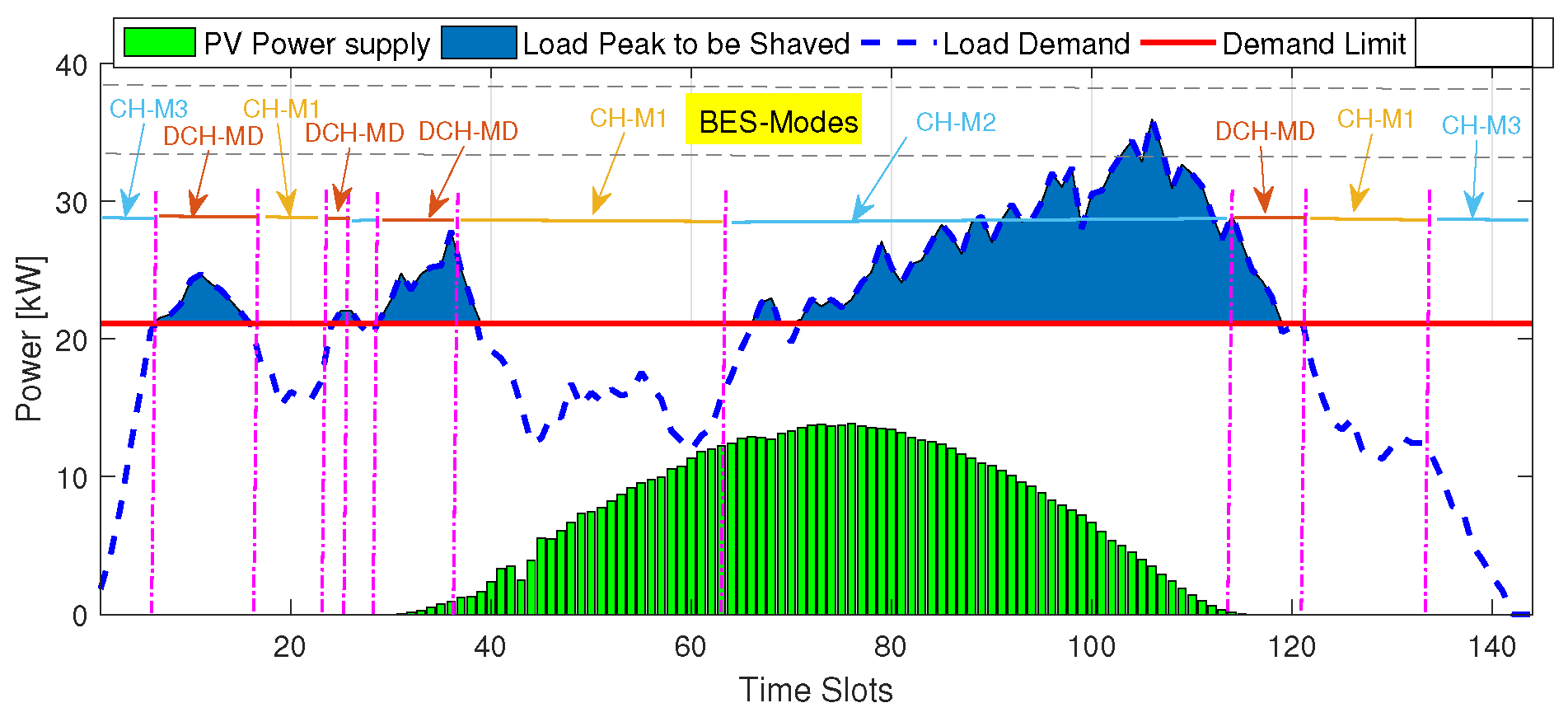
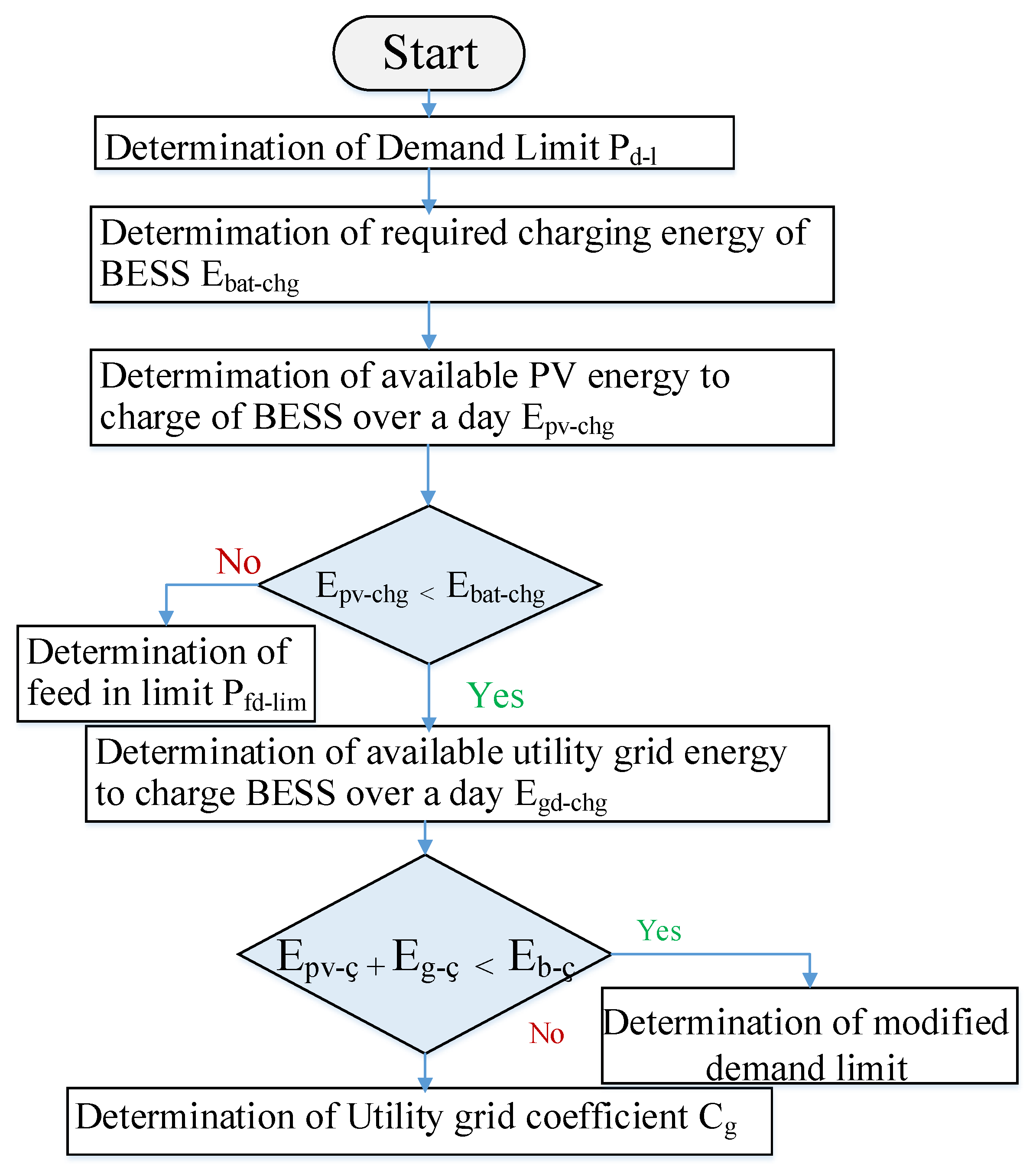
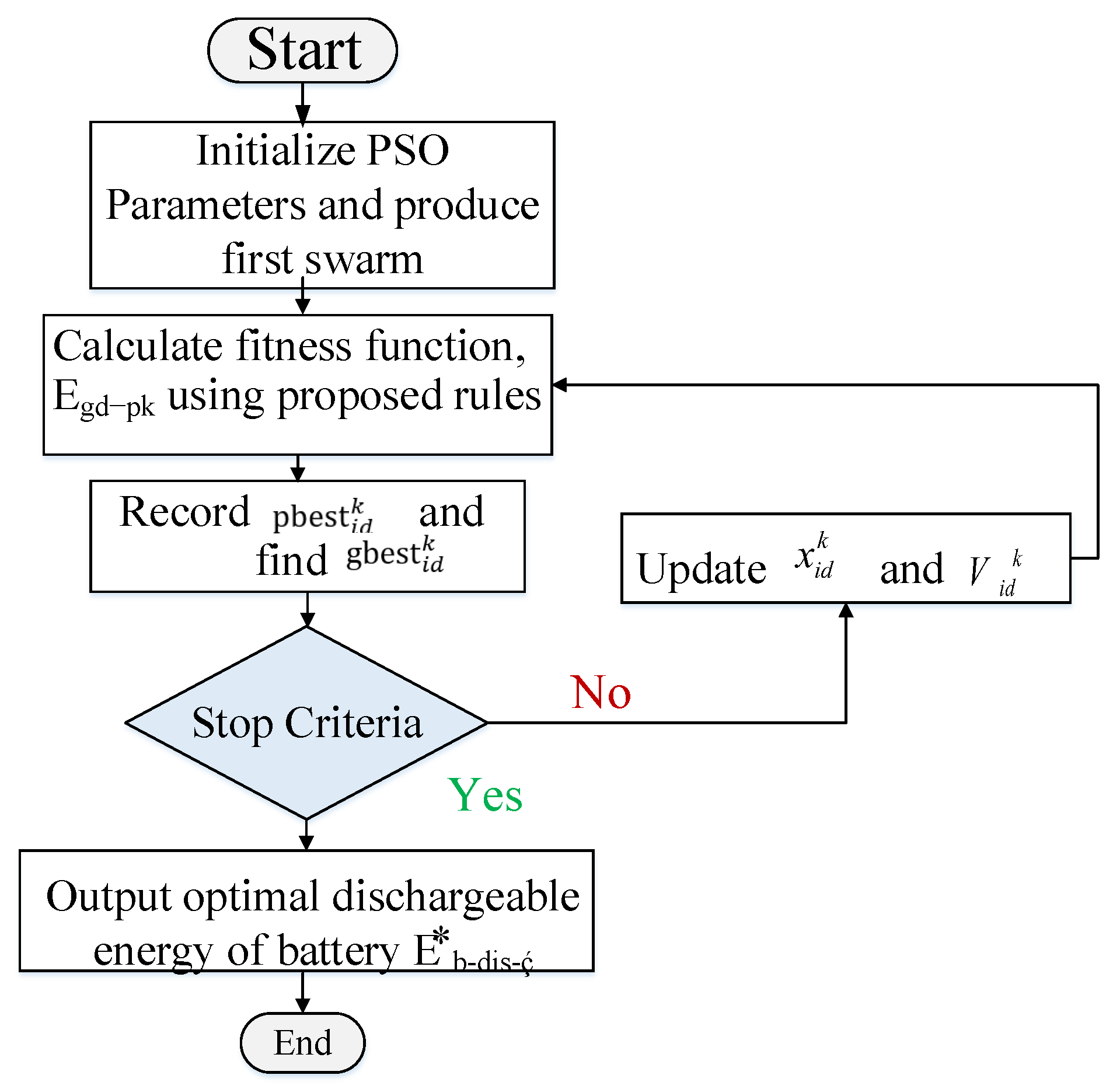

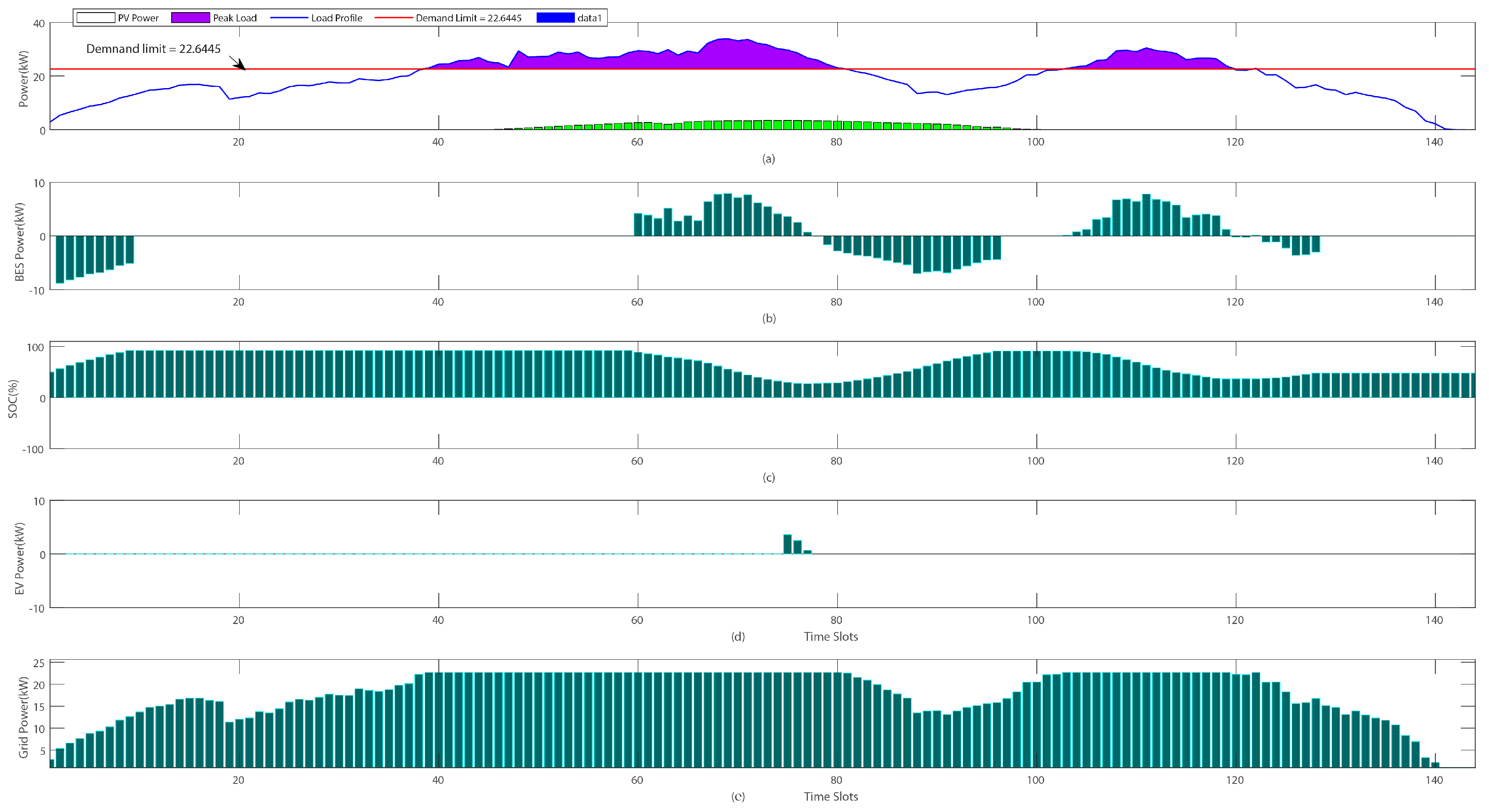
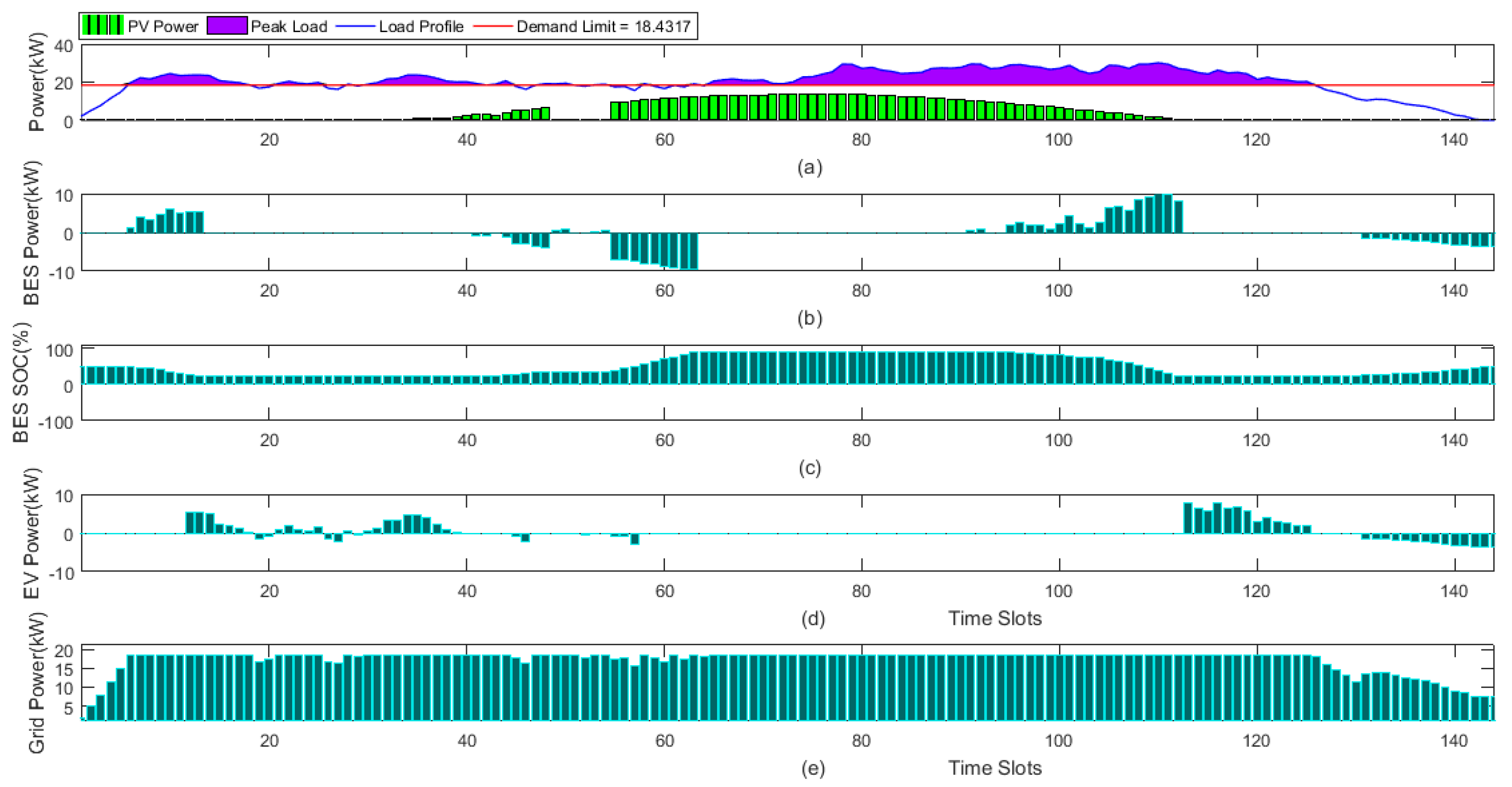
| Controllable Appliances | Summers Operating Hours | Winters Operating Hours | |
|---|---|---|---|
| Air Conditioner | 1 to 4, 21 to 24 | 4 to 6 | |
| Electric Heating Appliance | NA | 5 to 8, 19 to 21 | |
| Washing Machine | 1 to 8, 15 to 20 | 1 to 11 | |
| Clothes Dryer | NA | 7 to 12 | |
| Dishwashing Machine | 1 to 13, 18 to 24 | 9 to 15, 16 to 24 | |
| Water pump | 1 to 8, 13 to 15, 20 to 24 | 1 to 7, 17 to 24 | |
| Electric Tea Kettle | 4 to 6, 10 to 12, 17 to 19 | 5 to 9, 11 to 1, 18 to 20 | |
| Food Steamer | 1 to 6, 9 to 11, 16 to 18 | 1 to 8, 10 to 12, 15 to 18 | |
| Air Conditioner | 1 to 6, 20 to 24 | 5 to 7 | |
| Electric Heating Appliance | NA | 6 to 8, 15 to 22 | |
| Washing Machine | 1 to 9, 17 to 21 | 1 to 12 | |
| Clothes Dryer | 7 to 15, 20 to 24 | 8 to 15 | |
| Dish-washing machine | 9 to 12, 15 to 18, 19 to 24 | 9 to 15, 16 to 1 | |
| Water pump | 9 to 10, 21 to 23 | 8 to 11, 20 to 22 | |
| Electric Tea Kettle | 6 to 10, 13 to 15, 18 to 20 | 6 to 10, 18 to 21 | |
| Food Steamer | 1 to 10, 12 to 14, 16 to 19 | 1 to 12, 16 to 19 | |
| Air Conditioner | 1 to 8, 19 to 24 | 5 to 9 | |
| Electric Heating Appliance | 15 to 20 | 7 to 9, 15 to 23 | |
| Washing Machine | 1 to 10, 17 to 22 | 1 to 13 | |
| Clothes Dryer | 11 to 18, 11 to 12 | 9 to 17 | |
| Dish-washing machine | 9 to 12, 12 to 17, 19 to 24 | 9 to 15, 19 to 23 | |
| Water pump | 1 to 11, 20 to 24 | 1 to 12, 20 to 24 | |
| Electric Tea Kettle | 8 to 13, 13 to 16, 19 to 21 | 8 to 13, 18 to 22 | |
| Food Steamer | 1 to 11, 12 to 15, 18 to 23 | 1 to 13, 17 to 22 | |
| Air Conditioner | 1 to 24 | 1 to 24 | |
| Electric Heating Appliance | 15 to 24 | 15 to 24 | |
| Washing Machine | 1 to 24 | 1 to 15 | |
| Clothes Dryer | 1 to 24 | 9 to 21 | |
| Dish-washing Machine | 10 to 3, 7 to 24 | 10 to 2, 5 to 24 | |
| Water pump | 1 to 24 | 1 to 24 | |
| Electric Tea Kettle | 11 to 14, 18 to 24 | 10 to 13, 18 to 24 | |
| Food Steamer | 1 to 12, 18 to 24 | 1 to 14, 18 to 23 | |
| Electric Vehicle | 1 to 7, 14 to 15, 19 to 24 | 1 to 11, 18 to 24 |
| Lower-Class | Middle-Class | Upper-Middle-Class | Higher-Class | |
|---|---|---|---|---|
| Electric Vehicle | - | - | - | 70 |
| Air Conditioner | 1 | 1.5 | 2 | 2.5 |
| Washing Machine | 0.5 | 0.5 | 1.5 | 1.5 |
| Electric Heating Appliance | 1.4 | 1.4 | 1.4 | 1.4 |
| Dish-washing Machine | 0.4 | 0.4 | 1.5 | 1.5 |
| Clothes dryer | 1.8 | 1.8 | 5 | 5 |
| Electric Tea Kettle | 1.5 | 1.5 | 1.5 | 1.5 |
| Water Pump | 0.5 | 0.5 | 1.5 | 1.5 |
| Food Steamer | 0.6 | 0.6 | 0.6 | 0.6 |
| (a) | |||||
| Modes | Rule | Utility Grid Power | |||
| DCM | 1 | ||||
| CM1 | 2 | ||||
| CM1 | 3 | ||||
| CM1 | 4 | ||||
| CM1 | 5 | ||||
| CM2 | 6 | ||||
| CM2 | 7 | ||||
| CM2 | 8 | ||||
| CM3 | 9&10 | ||||
| (b) | |||||
| Input Parameter | Case 1 | Case 2 | Case 3 | ||
| kw/kWh | OPS | Ref. | OPS | Ref. | OPS |
| 18.43 | 19.93 | 22.64 | 23.5 | 18.43 | |
| 122.45 | 156.37 | 111.3 | 127.42 | 124.68 | |
| 95.74 | 87.81 | 43.84 | 48.56 | 90.86 | |
| 28.02 | 0.4 | 118.65 | 86.97 | 28.02 | |
| 0.3 | 60.57 | 0.15 | 0.16 | 0.3 | |
| NA | NA | NA | NA | NA | |
| 2.60 | 2.24 | NA | NA | 2.60 | |
| Parameter | Value | Parameter | Value |
|---|---|---|---|
| 36 kW | 0.2/0.9 | ||
| 15 kW | 0.5 | ||
| 132 kW | 10 kW | ||
| 600 Ah | 10 kW | ||
| 170 kW | 10 kW |
| Parameters | PUGP (kW) | PPS (%) | ||
|---|---|---|---|---|
| Schemes | Case 1 | Case 2 | Case 1 | Case 2 |
| Reference [14] | 19.1321 | 23.5445 | 43.55 | 30.53 |
| Proposed DHEMS | 18.4317 | 22.6145 | 49.15 | 38.12 |
| Parameter | Reference Literature | Proposed | ||||
|---|---|---|---|---|---|---|
| [13,22,23] | [24] | [25] | [26] | [27] | ||
| HEMS based Stage | NC | NC | NC | NC | Dynamic | |
| Demand Limit | Fixed | Fixed | NC | Dynamic | Dynamic | Dynamic |
| Feed in limit | NC | NC | Dynamic | NC | Dynamic | Dynamic |
| Electric Vehicle | NC | NC | NC | NC | NC | Considered |
| Daily management | NC | Flexible | NC | NC | Flexible | Flexible |
Disclaimer/Publisher’s Note: The statements, opinions and data contained in all publications are solely those of the individual author(s) and contributor(s) and not of MDPI and/or the editor(s). MDPI and/or the editor(s) disclaim responsibility for any injury to people or property resulting from any ideas, methods, instructions or products referred to in the content. |
© 2023 by the authors. Licensee MDPI, Basel, Switzerland. This article is an open access article distributed under the terms and conditions of the Creative Commons Attribution (CC BY) license (https://creativecommons.org/licenses/by/4.0/).
Share and Cite
Abbasi, A.; Sultan, K.; Afsar, S.; Aziz, M.A.; Khalid, H.A. Optimal Demand Response Using Battery Storage Systems and Electric Vehicles in Community Home Energy Management System-Based Microgrids. Energies 2023, 16, 5024. https://doi.org/10.3390/en16135024
Abbasi A, Sultan K, Afsar S, Aziz MA, Khalid HA. Optimal Demand Response Using Battery Storage Systems and Electric Vehicles in Community Home Energy Management System-Based Microgrids. Energies. 2023; 16(13):5024. https://doi.org/10.3390/en16135024
Chicago/Turabian StyleAbbasi, Ayesha, Kiran Sultan, Sufyan Afsar, Muhammad Adnan Aziz, and Hassan Abdullah Khalid. 2023. "Optimal Demand Response Using Battery Storage Systems and Electric Vehicles in Community Home Energy Management System-Based Microgrids" Energies 16, no. 13: 5024. https://doi.org/10.3390/en16135024
APA StyleAbbasi, A., Sultan, K., Afsar, S., Aziz, M. A., & Khalid, H. A. (2023). Optimal Demand Response Using Battery Storage Systems and Electric Vehicles in Community Home Energy Management System-Based Microgrids. Energies, 16(13), 5024. https://doi.org/10.3390/en16135024





